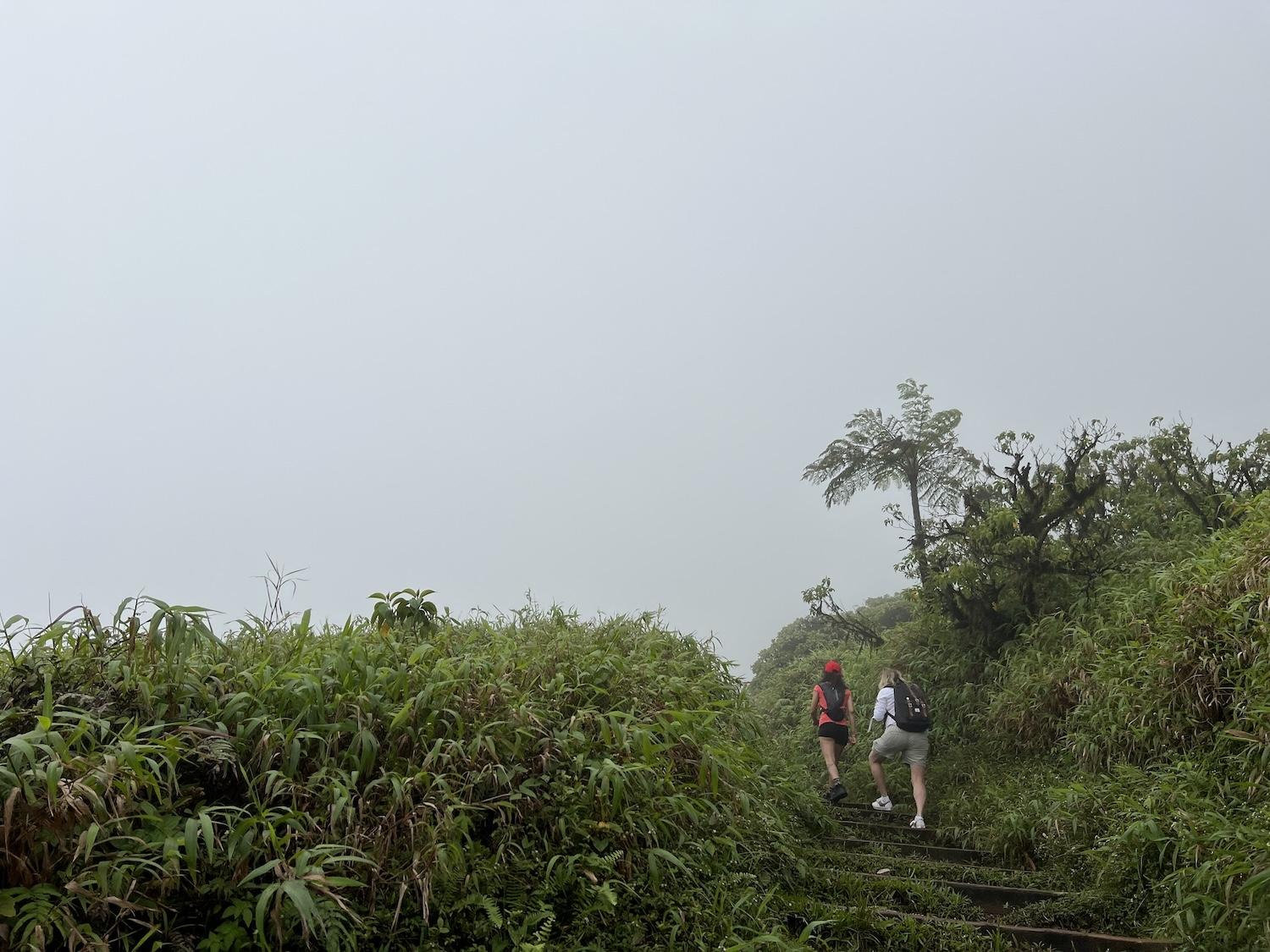
When you're hiking Mount Pelée in Martinique, the volcano is often shrouded in fog/Jennifer Bain
It’s never easy to climb Mount Pelée, Martinique’s UNESCO-protected volcano that killed nearly 30,000 people when it erupted in 1902. The hike is steep, slippery and treacherous, and fog can obstruct what should be well-earned views. And yet it's a bucket list hike for those of us who love a challenge.
With only an hour to spare, I made it through a quarter of the trail. Still, I set off from the parking lot determined to at least plant my feet on volcanic soil. Joggers and stoic tourists passed by as I dodged puddles of rain water, stepped gingerly over rocks and pulled myself up rudimentary steps that were sometimes spaced farther apart than my legs could handle. A couple of more honest souls muttered expletives, one even admitting the mountain had reduced her to tears.
It was December, part of the off-season on the Island of Flowers, but there were a few pretty things to photograph. And while sitting on a rock quietly hydrating in the heat, I glimpsed a blue-headed hummingbird searching for food.
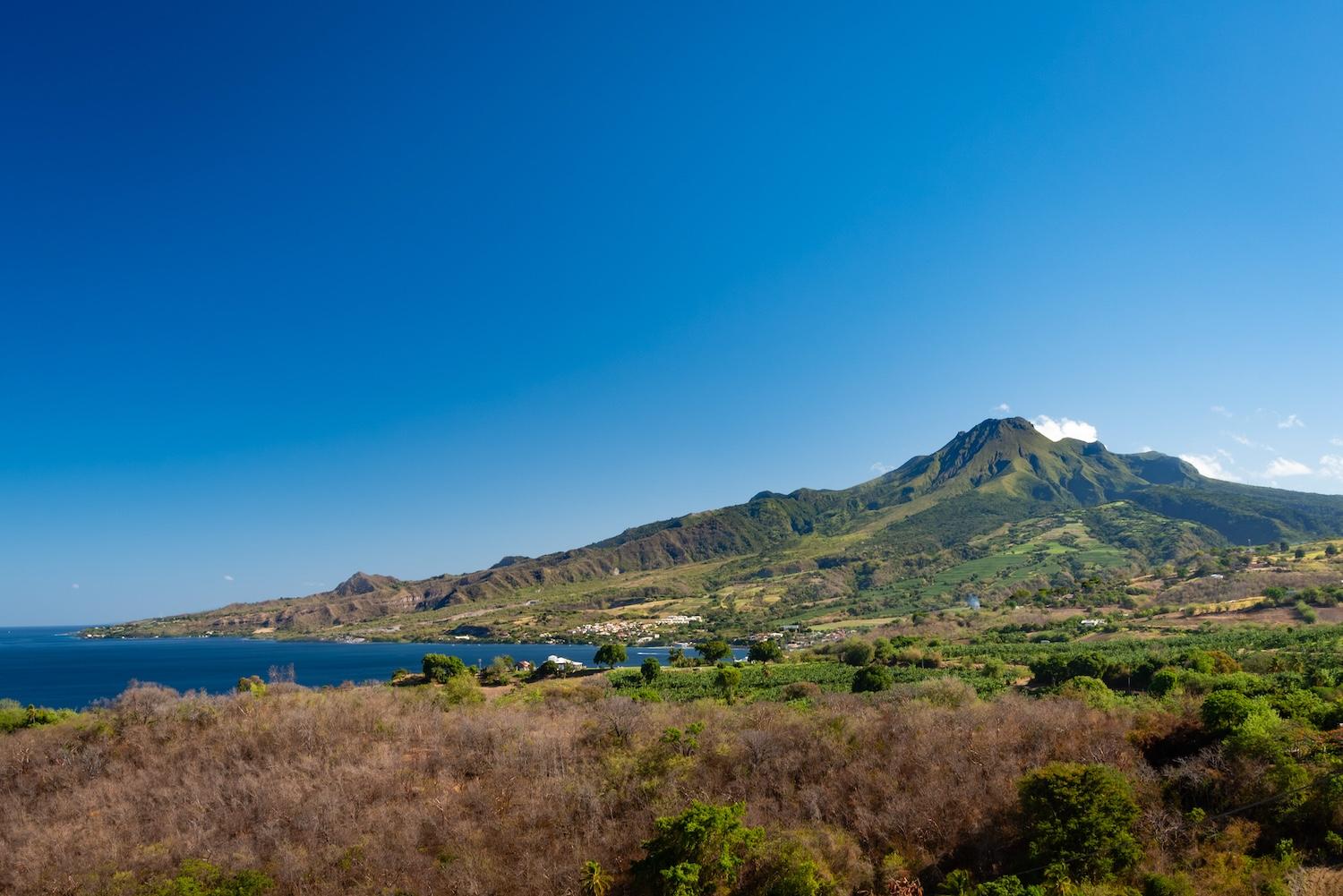
An unobstructed view of Mount Pelée in northern Martinique/Martinique Promotion Bureau
I would have loved to have more time for Mount Pelée during a four-night trip to the island, but I felt better when I spoke to Gabrielle Mauvois who is from the Parc Naturel Régional de la Martinique and has been in charge of the UNESCO dossier since 2015.
When UNESCO delegates came for a site visit to decide whether the Volcanoes and Forests of Mount Pelée and the Pitons of Northern Martinique should be added to the World Heritage List, they actually only had an hour for their own volcano hike.
“We walked just like you, one hour on the mountain, and we came back,” said Mauvois. “You would have seen some endemic flowers, trees and ferns like we did. There is fauna, hummingbirds, insects and spiders. You can have a slow pace if you like. You don’t have to run. It doesn’t have to be difficult.”
Some of the pretty, though likely invasive, flora on Mount Pelée/Jennifer Bain
Next time I visit, she promised, we can do the entire hike together. What matters now is spreading the message about how important Martinique’s forests are in terms of conservation and biodiversity.
In September, UNESCO gave the site its blessing because of its representation of volcanic features, materials and processes, and because the eruption is a key event in the history of volcanology. “A whole tourist ecosystem is unfolding and will continue to emerge around Mount Pelée and the Pitons of Carbet,” the Martinique Tourism Authority declared in a news release.
Martinique — nestled between Dominica and Saint Lucia in the southern Caribbean — is a French overseas territory with infrastructure on par with the rest of the European Union. All of its beaches are public and so you won’t find many beachfront hotels. There is only one all-inclusive resort on the remarkably unspoiled island. The entire island, and its surrounding waters, has been a UNESCO World Biosphere Reserve since 2021.
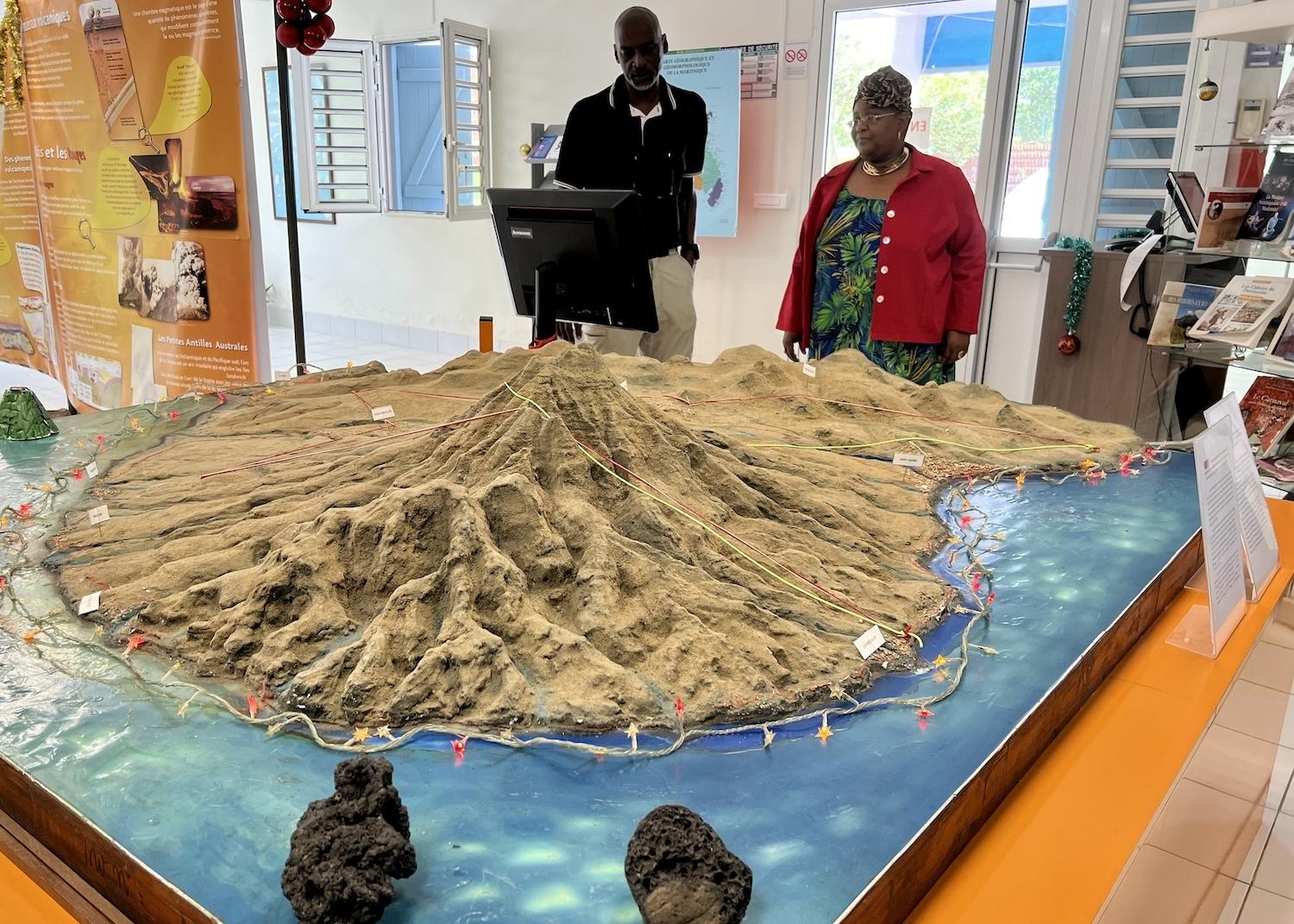
At La Maison des Volcans, hiking expert Gilles Vicrobeck speaks with the museum's Frédérique Burgo/Jennifer Bain
Truth be told, Mount Pelée isn't the easiest place to build or maintain trails. The most popular hike is along a trail called l'Aileron. There’s a small parking lot, and a somewhat hidden café, beside a faded sign marking the the trailhead and the out-and-back route.
Pélean eruptions are unique in the world and make Mount Pelée special. The landscapes, geology and the protected endemic and irreplaceable flora and fauna were also recognized as special. Globally threatened species such as the Martinique Volcano Frog (Allobates chalcopis) and the Lacépède’s Ground Snake (Erythrolamprus cursor), as well as the endemic Martinique Oriole (Icterus bonana), call this area home.
I didn’t luck into spotting any of those creatures, but made time to visit La Maison Des Volcans in Morne Rouge and the Mémorial de la Catastophe de 1902 — Musée de Frank A. Perret in Saint-Pierre to learn more about volcanoes.
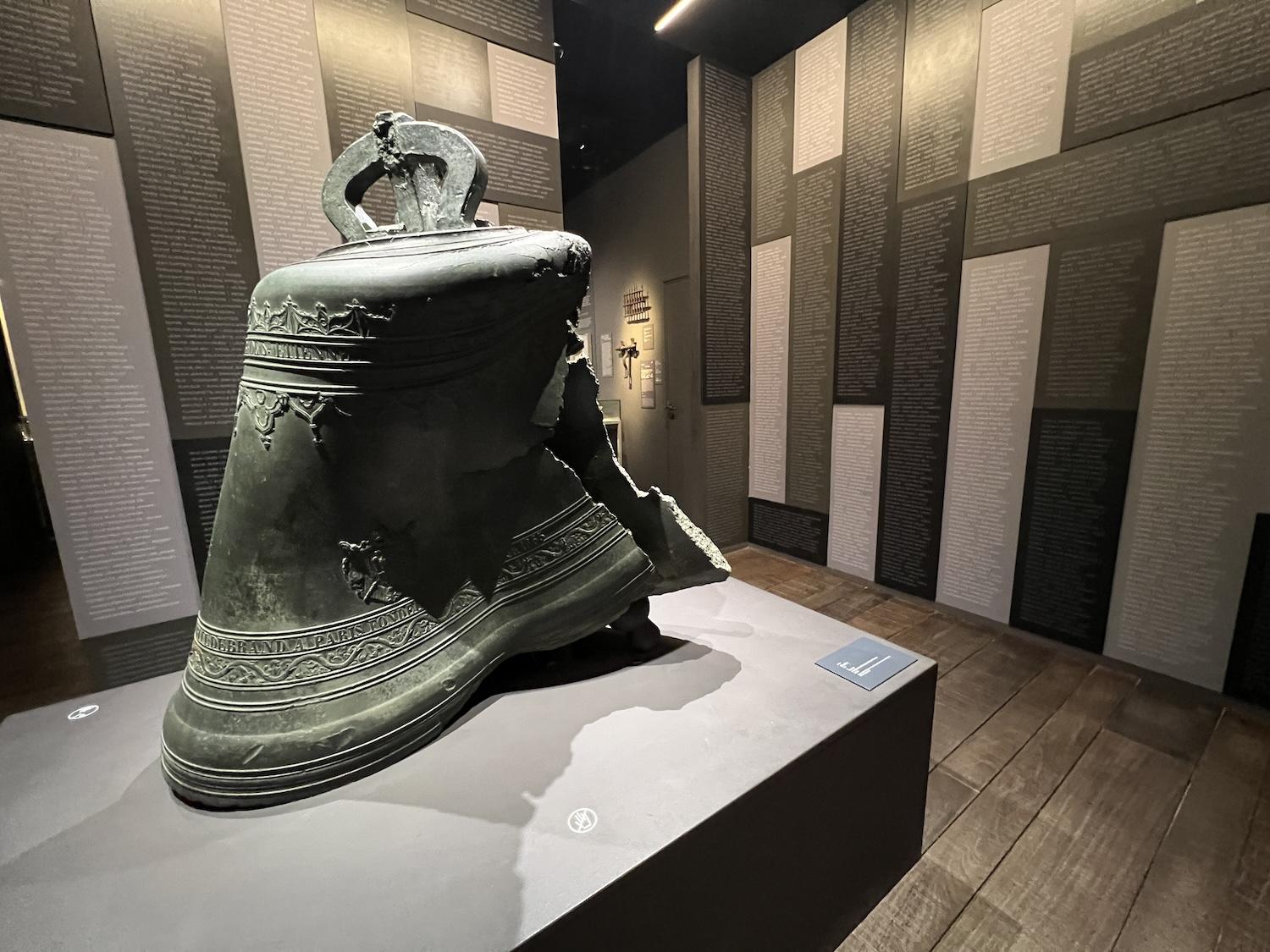
A church bell from the 1902 Mount Pelée eruption is on display at Mémorial de la Catastrophe de 1902 — Musée Frank A. Perret in Martinique. On the walls are names of some of the eruption's victims/Jennifer Bain
On May 8, 1902, when Montagne Pelée erupted, it devastated the town of Saint-Pierre at the foot of the volcano and killed roughly 28,000 people. Legend has it that only a few lucky souls survived, namely Louis-Auguste (Ludger) Cyparis, a prisoner in an underground cell who went on to travel with the Barnum & Bailey circus and tell his wild tale.
Inside the Frank A. Perret museum, which was named for an American volcanologist, one sombre room showcases a dented bronze church bell. The walls in that room feature the names of the 7,045 victims who have been identified.
“Those who witnessed the eruption on 8 May 1902 described a deafening explosion followed by a violent squall, a dark cloud of gas and vapour traversed by rolling sheets of lightening then a deluge of rocks and scalding mud,” interpretive signage explains. “In a minute, the cloud reached Saint-Pierre igniting the town and the ships at anchor offshore.”
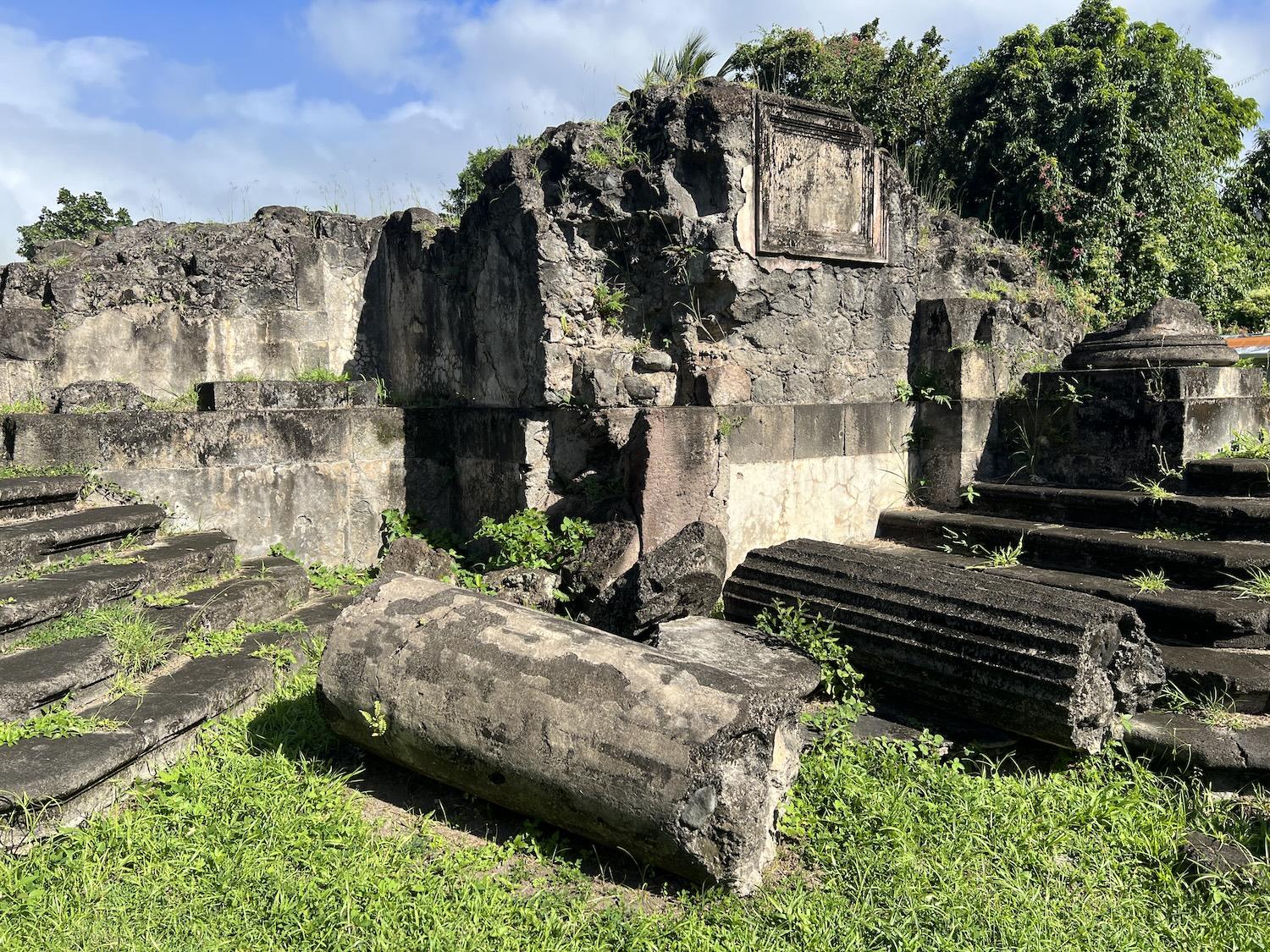
In Saint-Pierre, you can visit the ruins of a church destroyed during the lethal 1902 eruption of Mount Pelée/Jennifer Bain
The people of Martinique had ignored the rumbling volcano’s warning signs for the last time. Mount Pelée is still active but last erupted in 1932.
In Saint-Pierre, I visited the ruins of the church where people were gathering when the volcano erupted, the ruins of a theatre, and the ruins of prison where Cyparis was held. At what remains of an asylum, I read how 200 patients, 14 nurses and five nuns perished in the eruption. I touched the metal inner structures of restraining chairs inside some of the tiny cells.
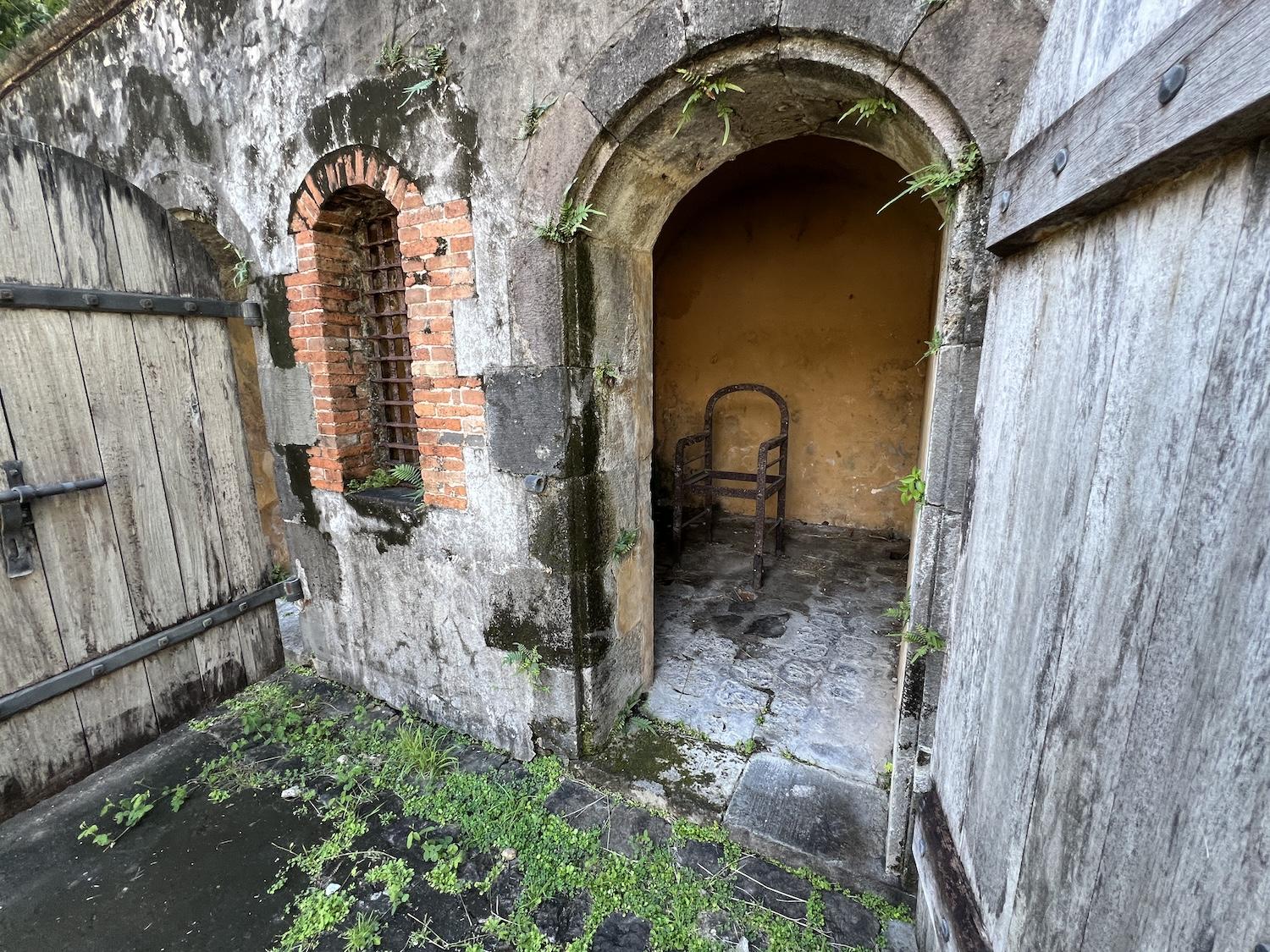
In a quiet corner of Saint-Pierre, you can tour a mental asylum destroyed in the 1902 eruption of Mount Pelée/Jennifer Bain
These ruins are just steps from lush green spaces. Much of the island is part of the Martinique Regional Nature Park, which protects 13,900 hectares (34,000 acres) of pure forest.
“We have a forest that is very preserved and representative of all the forest types of the Lesser Antilles,” Mauvois explained. “They have not been destroyed by urbanism and agriculture.”
She suggested three ways to experience Mount Pelée — on a flightseeing trip with Airawak, by hiking as I did, or by admiring the mountain while driving along the Route de la Trace. The Trace Road, as it's called in English, is 30 kilometres (18 miles) long and connects the capital city of Fort-de-France with the north.
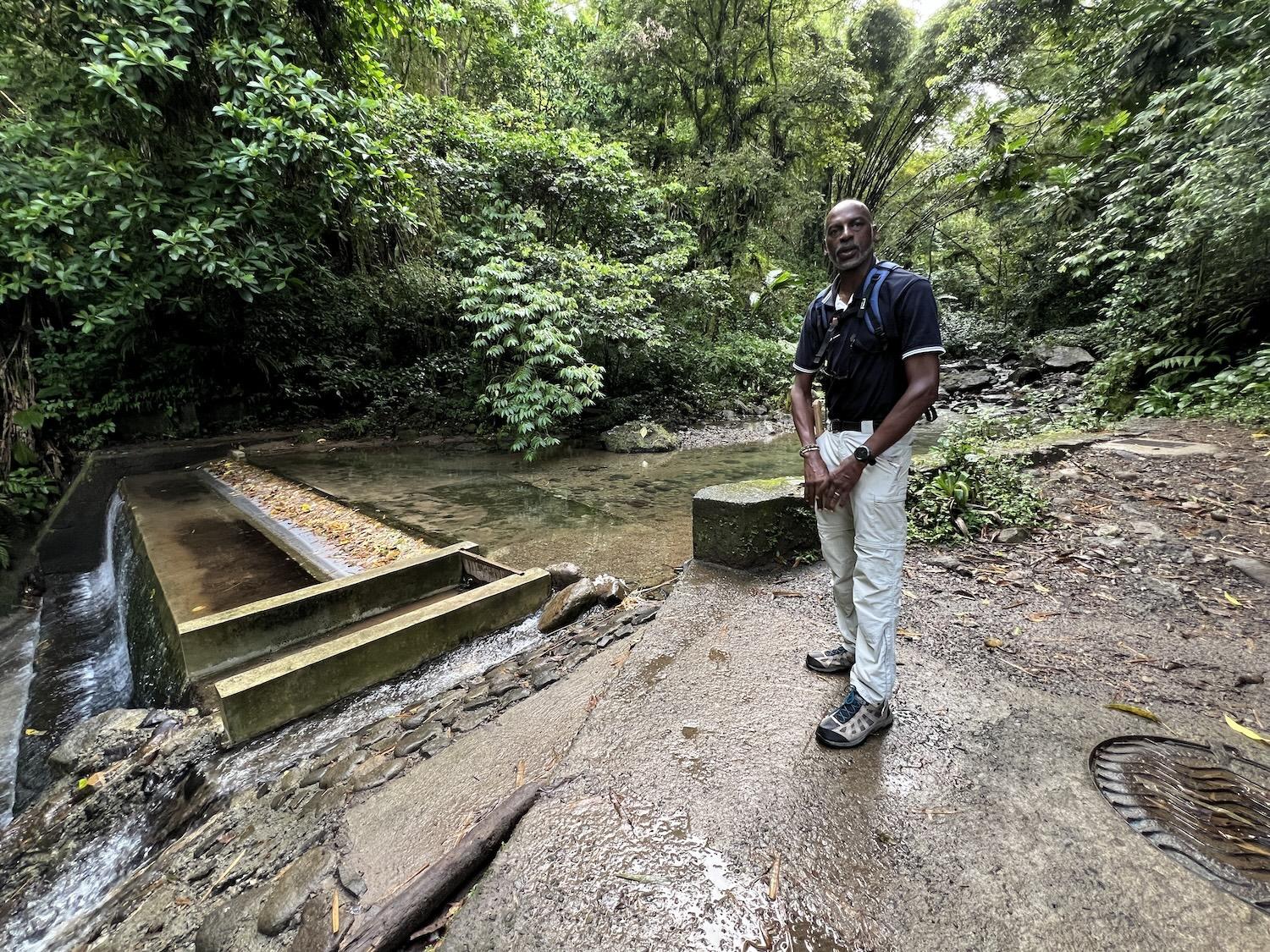
A footbridge is planned for hikers who take the Fontaine Didier-Absalon trail in Martinique and must cross this small area of water. Gilles Vicrobeck, who manages the island's trails and hiking clubs, offers guided hikes/Jennifer Bain
I travelled the Trace Road on a leisurely day with Gilles Vicrobeck, president of Festival International de la Randonnée Martinique and CEO of the Comité de la Randonnée Pédestre de la Martinique.
We hiked the Fontaine Didier-Absalon trail, a gentle 90-minute rainforest route between the Didier water factory and abandoned thermal baths. “I like this tour because you have the river singing all the way,” Vicrobeck confided. He has been hiking since he was nine years old and manages an impressive 385 kilometres (240 miles) of marked trails plus 32 hiking clubs.
As we hiked that Monday morning, we ran into tourists clad in wetsuits and helmets who were going canyoning in the area's river. On weekends, Vicrobeck said, the popular trail is like a highway.
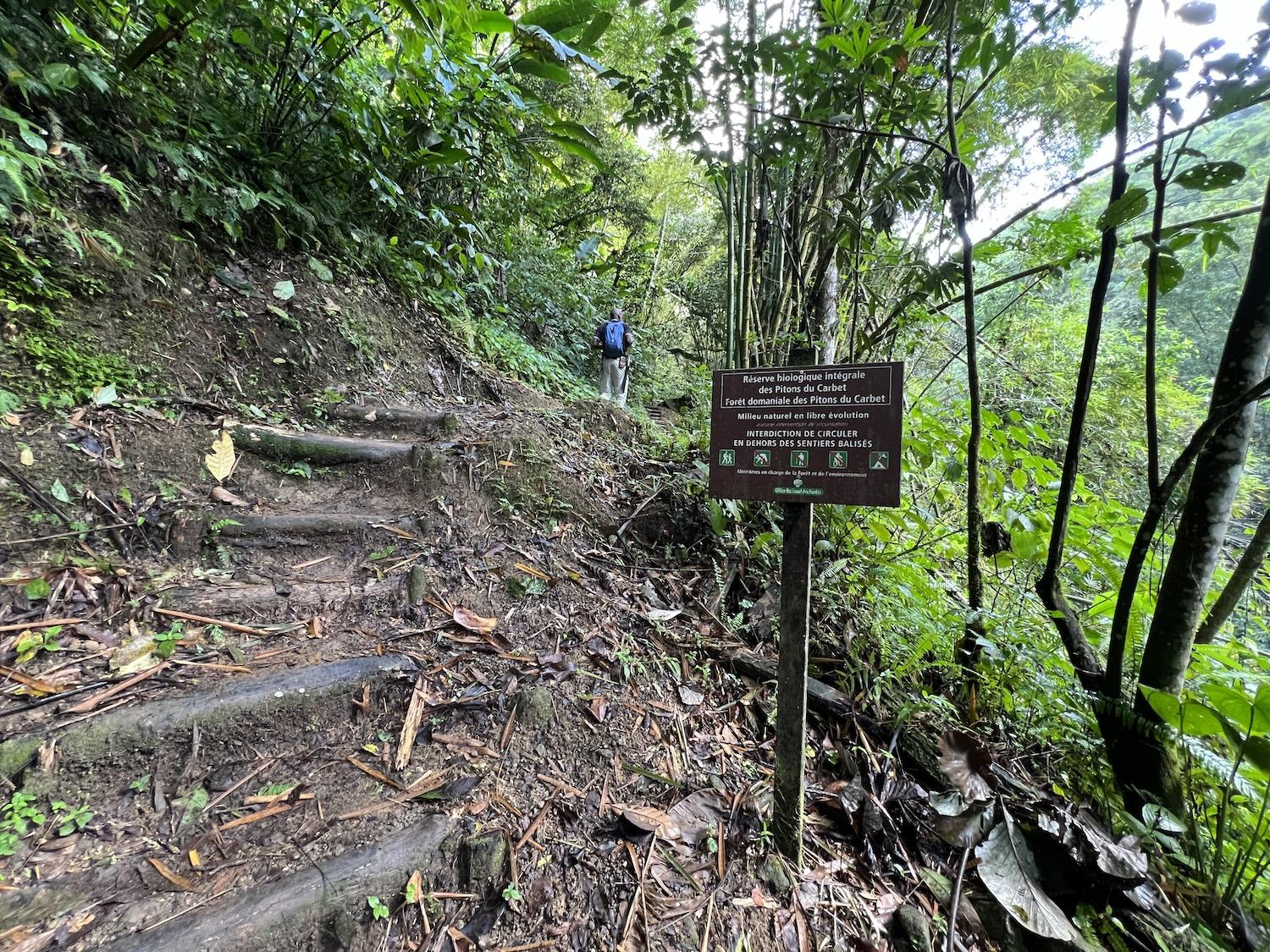
On the Fontaine Didier-Absalon hiking trail, you will walk on protected land (known as Réserve Biologique Intégrale)/Jennifer Bain
Didier is the only naturally carbonated water in the Caribbean, and I drank it at almost every meal. Discovered in the rainforest by the French army in 1833, the source of Didier was first used for a spa and then bottled and sold for its therapeutic virtues. In 1945, with the decline of hydrotherapy, a water plant was established. The gases in the mineral water are now separated during extraction and then reinjected before bottling.
After that hike, we stopped along the Trace Route at a spot where locals fill up their water jugs with free water. Salton Devon Adrien, who owns SDA Taxi, encouraged me to fill up my water bottle and try it. Then he took me to a local woman's home to admire the food that grows in her garden to be used in her Creole cooking.
Tiny Martinique boasts nine ecosystems — tropical rainforest, high altitude vegetation, semi-humid forest, dry forest, rocky coasts, beaches and sandy shores, seagrass beds, and reefs and rivers. With just four days on the island, there wasn't time to see everything, and I missed the garden at Le Domaine d'Émeraude. Created by the Martinique Regional Nature Park on 60 acres of tropical rainforest, its three trails and "nature exploration pavilions" showcase the island's biodiversity.
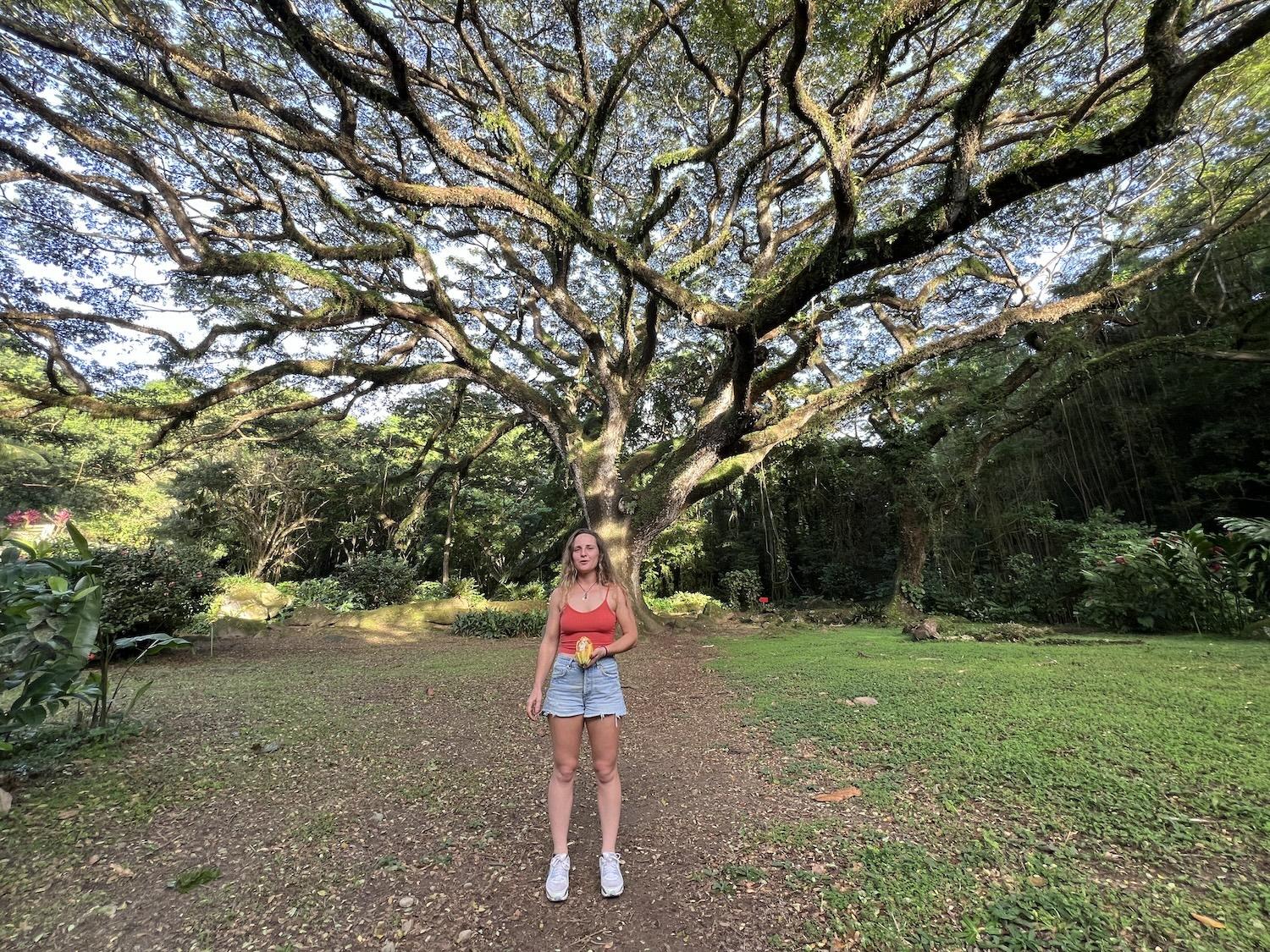
At Habitation Céron, Julie Marraud des Grottes stands by the famous Zamana tree/Jennifer Bain
Domaine d'Èmeraude is in a buffer zone just outside the protected park land. So is Habitation Céron, a former sugar cane plantation that now makes chocolate and offers inventive, locally foraged meals. It was here that I strolled through more tropical forest to see cacao trees and the mammoth Zamana tree (Samanea saman) that once sheltered cocoa and coffee plantations and won France’s Arbre De L’Année (Tree of the Year) competition in 2016.
This particular 300-year-old Zamana survived the deadly Mount Pelée eruption. Now it must tolerate camera-toting fans and the occasional tree-dwelling Matatou Falaise (Caribena versicolor).
Several of these Antillles Pintoe Tarantulas lounged on the Zamana about six feet above the ground. They start out as electric blue spiderlings, but turn green and red as adults. Once victims of trafficking by unscrupulous breeders because they're docile enough to turn into pets, these fuzzy and feared endemic creatures are now protected at a national level on Martinique. I took a few photographs and then let them be.
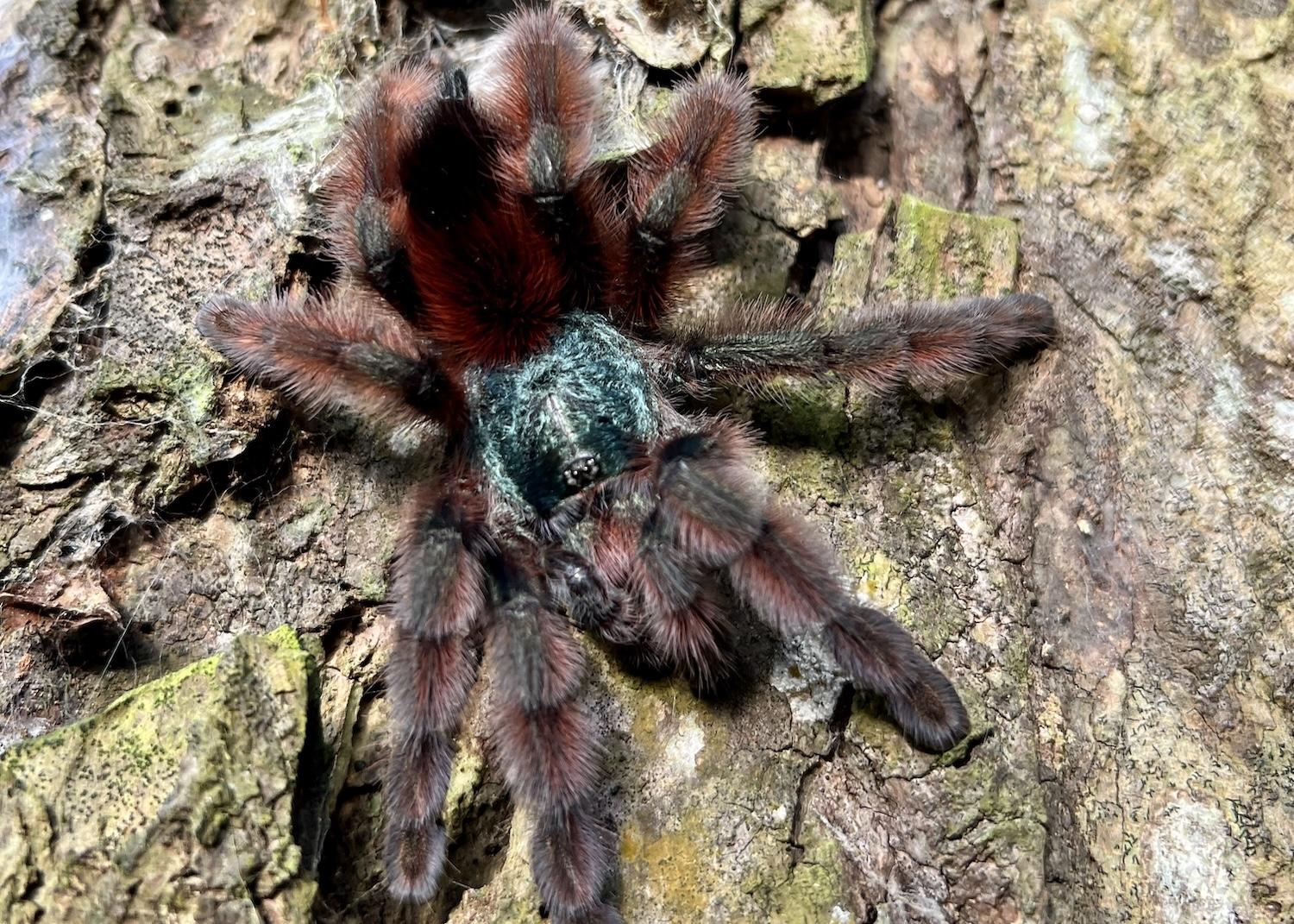
At Habitation Céron, this lovely and docile tarantula (Matoutou Falaise) lives on trees/Jennifer Bain


